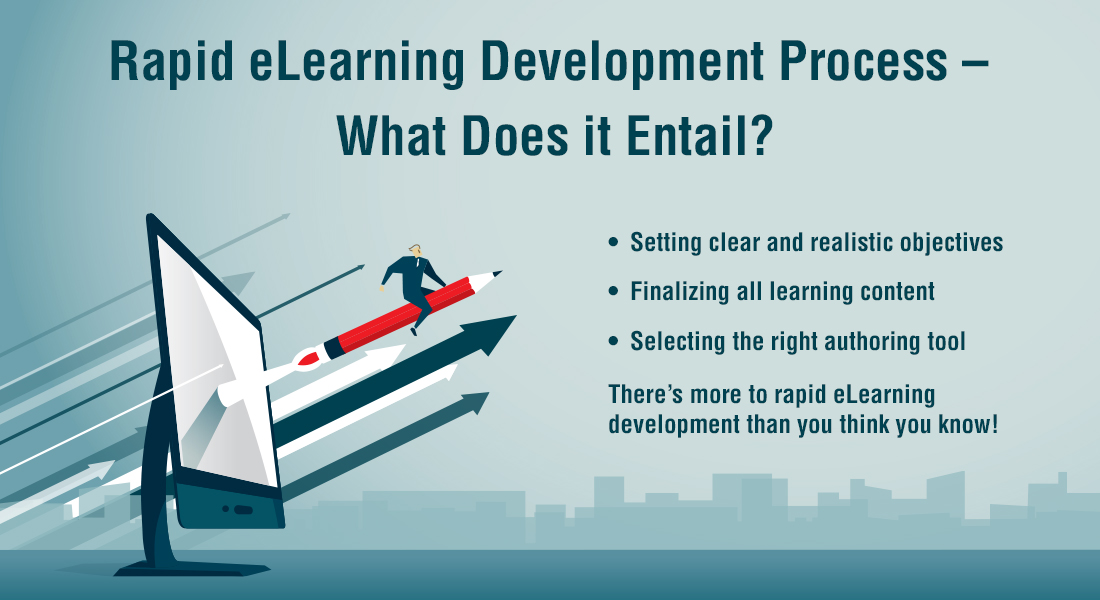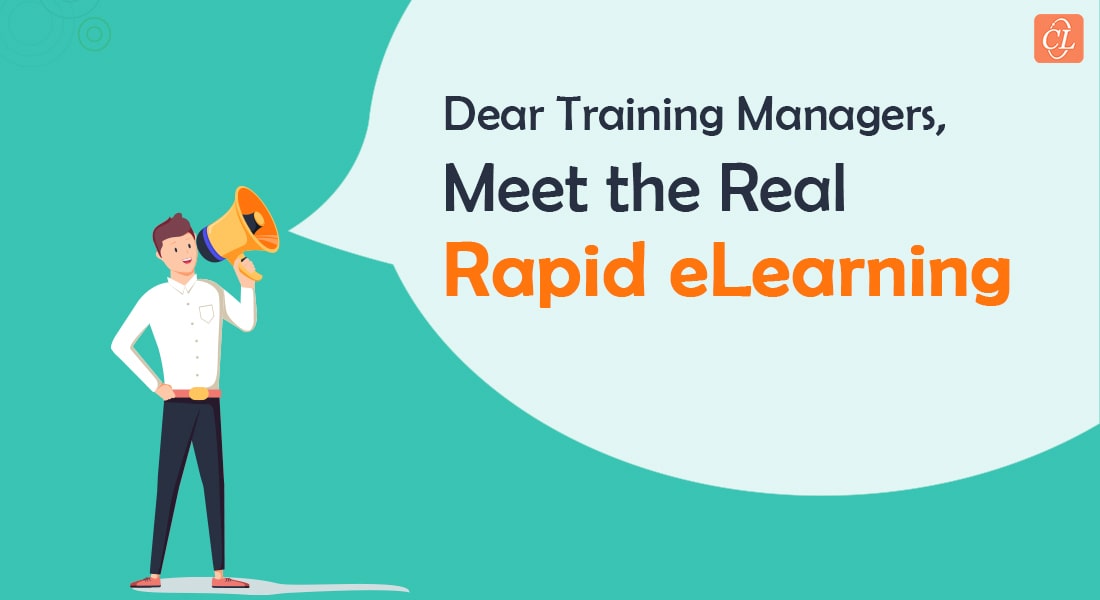5 Steps for Seamless Rapid eLearning Development

Rapid eLearning is the talk of the corporate training town. COVID-19’s unprecedented forcing of all workplaces to ‘work from home’ has only increased the demand for eLearning for corporate training. This has led to an increased demand for rapid eLearning. Why? Because as indicated by its name, rapid eLearning development rolls out eLearning courses much faster than your conventional eLearning courses, yet retaining the best of what it has to offer. Needless to say, such high-quality outputs call for a high-quality rapid eLearning development process. If that is what you are also concerned about, this blog is for you.
Wondering How to Streamline Rapid eLearning Development?
Here are the 5 steps for seamless execution:
- Start by setting clear and realistic learning objectives
- Finalize all learning content before development
- Brainstorm and select the right authoring tool
- Use pre-existing standardized templates
- Follow the AGILE process of development
Corporate training in the 21st century mandates quick and robust delivery of training, as most companies work quite dynamically nowadays. New products are launched every month and old products updated frequently. Not to mention the steady influx of newly hired employees, whose onboarding needs to be taken care of. In these times when time and budget are the two defining criteria, rapid eLearning, by cutting down the course design and development time by at least 40%, checks out both.
Keep Yourself Updated with the Happenings in the Corporate L&D Space; Discover What’s Trending.
Rapid eLearning Development – 5 Steps to Take Care of
Although building a rapid eLearning course is not rocket science, it’s not a disorganized mess with designers and developers fighting either. There is a robust five-step process which helps place all the gears in their right place and smoothens the process to build high-quality online courses.
Step 1: Establish Clear and Realistic Learning Objectives
Proper planning is a must in rapid eLearning development to successfully develop effective eLearning courses. Not having clear learning objectives will lead to a lot of confusion, and may result in a subpar eLearning course. Here are four questions you can ask:
- In what ways is the training relevant to the learners?
- What should the learners be able to do after the training program?
- Will the training program be limited to one eLearning module or a curriculum of courses?
- How will you evaluate how much the learners have learned and understood?
Answers to these questions will help you set SMART learning objectives – specific, measurable, achievable, relevant, time-bound – that are essential for any successful eLearning.
Step 2: Finalize Learning Content before Development
Once you have set the learning objectives, it’s time to move to development. Understand this – rapid eLearning course development relies heavily on old and existing classroom training materials. Nonetheless, these older training materials often have a lot of gaps in content. Old classroom or ILT (Instructor-led Training) materials, for instance, contain only half the information in written / visually decipherable form, with the remaining half in the trainer’s head. Sometimes the training materials are so old that their outdated content is not suited for the present training requirements. Besides, chances are, your courses were built in Adobe Flash, which is being phased out this December. So, you are stuck with a library full of antique courses.
In those cases, SMEs can help update the course content, look for errors or outdated information, and trim any unnecessary content. Before the course goes for development, the units and sub-units are also finalized to ensure proper flow of information. Remember, the more focused and better organized your learning content is, the more effective the eLearning course will be.
Step 3: Decide on the Authoring Tool
Selecting the right rapid authoring tool for your course development is quite like selecting the perfect car – the best ones are those that match your requirement exactly, without having to pay for the additional bells and whistles that you are not ever going to use.
There are scores of rapid authoring tools in the market today, and selecting the right tool goes a long way in developing the right eLearning course. It’s always better to stick to the leading names in the industry, like Articulate Storyline, Trivantis Lectora, or Adobe Captivate. While some authoring tools help in the quick and easy conversion of classroom PPTs to eLearning modules (iSpring), others are perfectly suited to create courses heavy in interactivities or scenarios. Of course you need some of the features that they have to offer, but surely you don’t need them all.
Given that rapid eLearning courses need to be ‘rapid’, authoring tools must also come with content and template libraries. Similarly, the kind of support they provide for mobile learning also needs to be taken into account. Fortunately, there is an 11 point checklist (read blog here) that can help you out in deciding the right authoring tool for developing eLearning courses.
Step 4: Leverage Pre-existing eLearning Templates
The objective of rapid eLearning development is to save time and money. Using templates for rapid eLearning is an excellent way to achieve that objective. Not only do online course templates help save time and money, they can also be customized to fit specific training needs.
Templates can also be standardized to make the learning experience uniform for all employees. Once saved, the designed templates can be reused in future courses. Standardizing the templates means standardizing the visual design and branding which ensures consistency across the courses, saving money and time.
Step 5: Use AGILE Development Process
The AGILE process of eLearning development is a highly iterative process that keeps all the stakeholders and the SMEs in the loop to ensure a smooth rapid eLearning course development.
The agile development process follows three steps:
- In the first step, the requirements and all relevant background information regarding the course is gathered.
- In the prototype phase, a small but fully functional model of the course is developed and sent for review.
- In the final phase, the actual course, with all text, images, videos, interactivities and audio narration is developed and published.
The agile process, by keeping the stakeholders and SMEs in the loop, ensures rework is kept to a minimum, and quality is not lost in the quest for speedy roll-out of courses.
It’s a Wrap!
And thus, is the development of rapid eLearning done. The actual development time of the course may not be in your hands. However, you can still ensure faster delivery by smoothing out the preliminary steps as much as you can. These 5 steps when followed, will always lead to good outcomes, if not better.
Want to know about rapid eLearning for quick rollout from more than just a blog? Don’t worry. I have a nice little FREE eBook for you. Click below.





